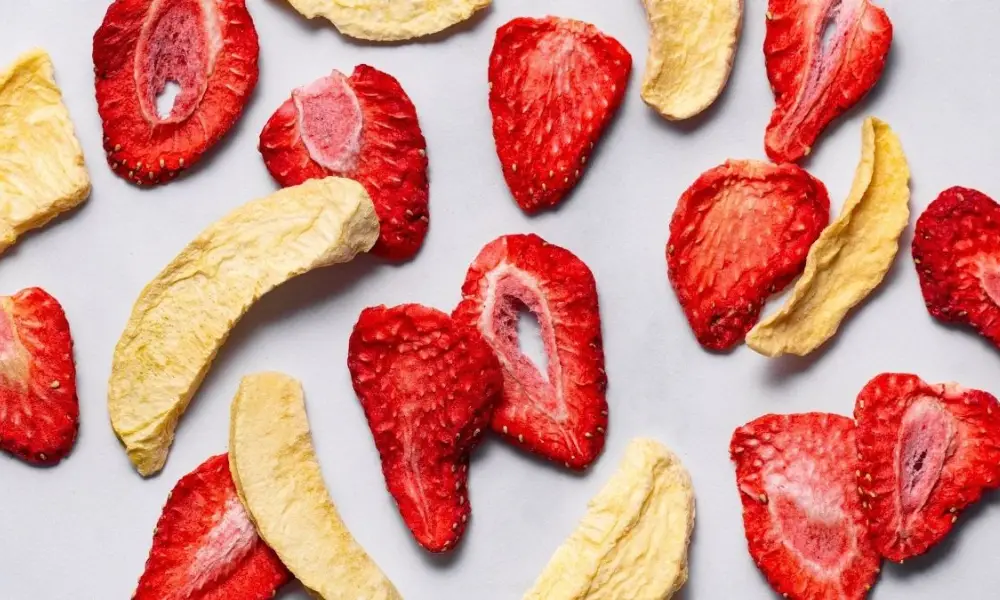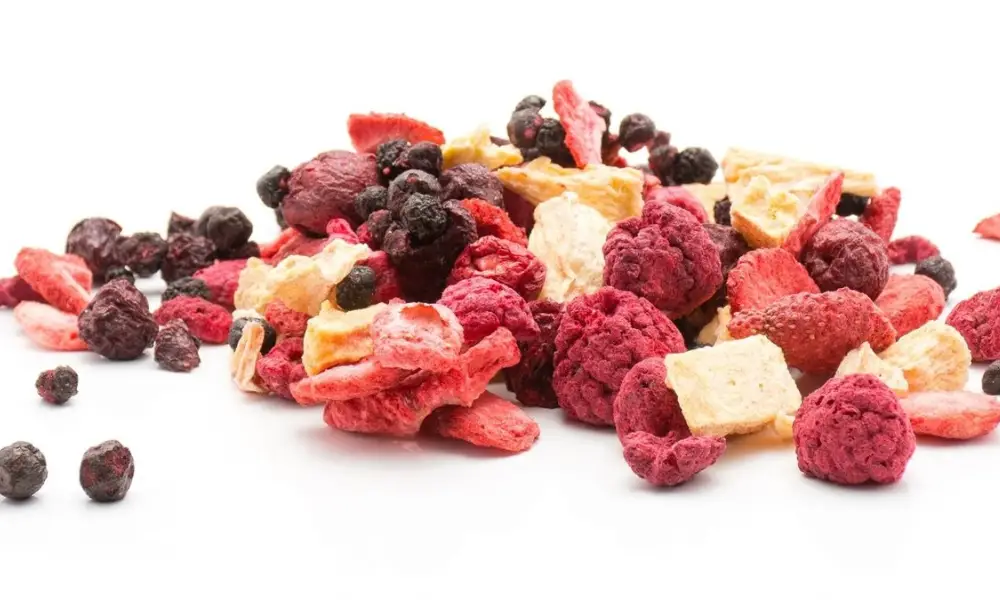When storing fruit, you can freeze it for a variety of reasons. It retains nutrients and makes an excellent emergency food. Additionally, it will store much longer than fresh fruit. Here’s how to freeze dry fruit. First, slice your fruit into thin slices. Slices can then be placed in a vacuum chamber under low heat. When the fruit thaws, water crystals will be removed. This process is called sublimation.
Fresh fruit can be freeze-dried to increase its shelf life; when done right, some varieties will keep for virtually endless periods of time. Owning a home freeze-drying equipment makes the procedure simpler, but these might be too expensive for some people. Fortunately, if you’re not in a rush, you can easily get the same results by using your personal freezer or a few blocks of dry ice.

How to Freeze Dry Fruit
Using Your Freezer to Dry Fresh Fruit
Choose fruits with a lot of water. Among the most preferred fruits to freeze-dry are pears, apples, berries, grapes, peaches, and acai berries. However, you might also use other fruits or vegetables that you might want to eat in the future, such as bananas, kiwis, mangoes, pineapples, citrus fruits, etc.
Foods with a lot of moisture are usually the easiest to handle. They become frosty when frozen, maintaining their structure as the moisture slowly evaporates.
If you’re new to freeze-drying, fruits are a great place to start because they’re among the easiest things to dehydrate.
Clean and dry your fruit. Put your fruits in a wire strainer or colander and run some cool water over them. Try to get rid of as much dirt, junk, and waxy residue as you can. When finished, use a layer of folded paper towels or a fresh, dry towel to pat the fruit dry.
It’s crucial to completely dry your fruit before continuing. The dehydration process will take longer if you start with wet fruit since more ice will need to melt in the freezer.
Your fruit should be placed on a sizable baking sheet. If at all feasible, place your fruit such that there is some space between each piece. While it’s acceptable for the edges to touch, avoid overcrowding the baking sheet since this can result in sticking. Better airflow is a direct result of more room, and faster freezing times follow. Feel free to arrange as many types on a single pan as you desire. Simply divide your offerings into categories to make sorting and storing them later on easier.
Alternatively, you can arrange your fruit on a metal cooling or drying rack if the pieces are large enough to fit without slipping.
Fruit can be frozen for up to 4 weeks. The fruit should now be placed in the freezer, and you should wait. Small quantities of damp fruits may totally dehydrate in as little as one week. Be prepared to leave them for a few weeks or maybe a month if you’re working with drier fruits or a variety of various types.
The ice in the fruit will gradually melt into vapor while it sits, a process known as “sublimation,” and then evaporate.
For the first week, avoid checking on your fruit or opening the freezer door until when absolutely essential. Even a slight increase in the freezer’s temperature can significantly lengthen the time it takes to complete your order.
Fruit should be kept in sealed containers either at room temperature or cooler. Once the fruit has completely dried out, take the baking sheet out of the freezer. Scoop the fruit into several resealable plastic bags, glass mason jars, or closed food containers using a spoon, spatula, or similar tool. Make a place in your fridge or freezer for these containers, or store them on a shelf in your pantry.
Freeze-dried fruit can keep for decades if it is kept dry and properly maintained.
Keep your freeze-dried fruit off your countertops. It can spoil considerably more quickly in your kitchen because of the excessive humidity and changing temps.
Fruit Preservation Using Dry Ice
To determine how much fruit you want to freeze-dry, weigh it all out. After choosing your fruit or fruits, put them in a light container, then place the container on a digital kitchen scale. The entire weight should be written down or noted in your head because this will help you determine how much dry ice to purchase.
If you’re going to be freeze-drying several pounds of fruit at once, you might be able to weigh your fruit using a regular bathroom scale. You’ll require a kitchen scale’s sensitivity for smaller batches.
Remember to properly wash and dry your fruit before freeze-drying it.
The weight of your fruit should be used as the basis for your dry ice purchase. In addition to ice cream businesses and party supply stores, many grocery stores also sell dry ice. For freeze-drying, you’ll need a 1:1 ratio of dry ice to fresh fruit, so make sure to buy enough.
You will require precisely 2 pounds (0.91 kg) of dry ice to freeze-dry 2 pounds (0.91 kg) of fruit.
Typically, a 1-pound (450 g) block of dry ice costs between $1 and $3.
Fruit should be divided into freezer bags with a tight seal. Cut larger fruits like apples, bananas, and plums into slices or chunks to make them fit better. Place little foods like berries and grapes in whole.
Prior to sealing the bags, squeeze out as much air as you can. Your fruit’s chances of spoiling too soon will increase if there is too much oxygen present.
As they are less prone to accidentally open, zipper bags are preferred to those that snap shut.
Label each bag of fruits you are freeze-drying with a permanent marker. That way, once their contents have been dried out, you’ll be able to discern what’s within with ease.
The fact that you won’t have to bother moving the frozen fruit to a different container afterward is one benefit of bagging your fruit before freezing it.
Put your fruit bags in a cooler with insulation. Spread the bags out so they are as flat as possible before placing them in the cooler’s bottom. To make the best use of your available space when freeze-drying a lot of fruit at once, stack the bags on top of one another.
Buy a cheap styrofoam cooler to use for freeze-drying if you already have a cooler but don’t like the notion of filling it with dry ice. A less expensive model will perform the same task just as well as one of them.
Never store dry ice in a freezer or refrigerator. Even in these locations, the temperature is far too low; without enough insulation, it will immediately melt.
Dry ice must completely round the apple. Shake the dry ice out of the package, then dump it on top of the fruit in the cooler. Make an effort to spread it out evenly. The fruit should ideally be scarcely discernible beneath.
Before adding it to your cooler, you might need to break apart any solid blocks of dry ice that arrived with it.
Always use gloves and set up your supplies in a well-ventilated area while working with dry ice. If it makes direct touch with your skin, it might burn you. In a similar manner, breathing in the vapors could cause respiratory irritation.
Fruit can be frozen for up to a day. Dry ice, which has a temperature in the neighborhood of 109 °F (78 °C), dries out food much more quickly than a regular freezer. It should be done dehydrating in around 24 hours if you are merely dehydrating 1-3 pounds (450-1,360 g) of fruit. It may take closer to 36-48 hours for really large batches of roughly 5 pounds (2.3 kg) or more.
When all of the dry ice has vanished from the cooler, your fruit is prepared to be removed.
Keep your freeze-dried fruit at or below room temperature. The bags should be carefully taken out of the cooler and placed on a shelf in your pantry. In order to keep them below 68-70 °F (20-21 °C), which is ideal for maximizing the lifespan of freeze-dried foods, you can also put them in the fridge or freezer.
What are the Uses of Freeze-Dried Fruit?
Eating freeze-dried fruit by hand, either alone or as a component of a snack mix or trail mix is the simplest way to consume it. Fruit that has been frozen can be added as a garnish to ice cream, yogurt, or cereal. It’s a great choice for traveling, hiking, and camping because it’s so small and light.
Because of its concentrated flavor, freeze-dried fruit is a fantastic way to add strong fruit flavor (and frequently color) to a recipe without adding additional liquid. Because it is so crispy, it can also be used whole, crumbled, or powdered as a garnish to improve the aesthetic and texture of a meal.
For a variety of uses, freeze-dried fruit needs to be processed into a fine powder in a blender or food processor. (Remember to take out the desiccant packet before adding the package’s contents to your blender.) For a coarser crumble, bash it with a rolling pin or frying pan after breaking it up with your hands.
How Should You Prepare Freeze-Dried Fruit?
Because freeze-dried fruit has such a long shelf life, it can be cooked with, added to sweet and savory dishes, and baked. Although additional water is needed to make the berries, banana chunks, or pineapple pieces plump up, freeze-dried fruit can be used in baking just like fresh fruit.
Fruit that has been freeze-dried can be used in waffles, pancakes, and baked products including muffins, cookies, and small pieces of bread. For a burst of fruit flavor, mix powdered freeze-dried fruit into frostings, fillings, whipped cream, or roll chocolate truffles in the powder.
The most popular fruit topping for cereal, yogurt, desserts, panna cotta, chocolate mousse, and other meals is freeze-dried fruit. Granola and trail mix are both fantastic additions to freeze-dried fruit. When using it as a topper or in a mix, moisture is not necessary. Fruit that has been freeze-dried has a light, crisp texture that is perfect for a variety of uses. Include freeze-dried fruit with the remaining ingredients before churning for delicious milkshakes and smoothies.
How Does Fruit that Has Been Frozen-Dried Taste?
Imagine the ripest fruit turning from delicious and velvety to airy and crisp. The flavour of freeze-dried fruit is remarkably similar to that. It is the dried form of popular fruits, such as strawberries, raspberries, apples, bananas, dragon fruits, kiwi, blues, pineapple, and other sweet fruits, during the peak season. Since freeze-drying retains flavor far better than dehydration, the flavors are brighter and more intense. Fruit that has been frozen and dried has a rough, dry, and crispy texture that gives it a satisfying crunch when you bite into it.
Reference: Effect of coating on post-drying of freeze-dried strawberry pieces
Conclusion
If you want to freeze-dry fruits, there are several methods. The first method uses hot water. It takes only a few minutes to rehydrate frozen fruit, and the flavor is remarkably close to its original state. The second method is based on removing water through the process of freeze drying. Freeze-drying occurs at low temperatures under very low pressure, which helps remove water without changing the fruit’s structure. Freeze-dried fruit and vegetables retain their original shape and size, while dehydrated fruit shrinks.
Freezing fruit is a great way to transport them. It also allows you to have fruit available year-round. However, freezing fruit does affect its appearance and flavor. Despite this, it does not decrease the nutritional content of fresh fruit. It may even preserve water-soluble vitamins. This means that frozen fruit may be as healthy as fresh fruit when added to smoothies.
